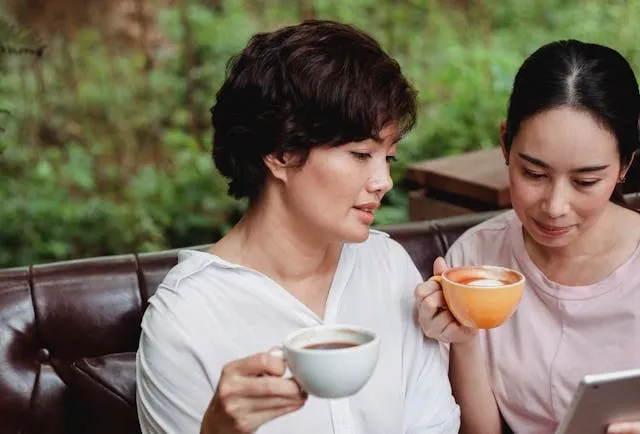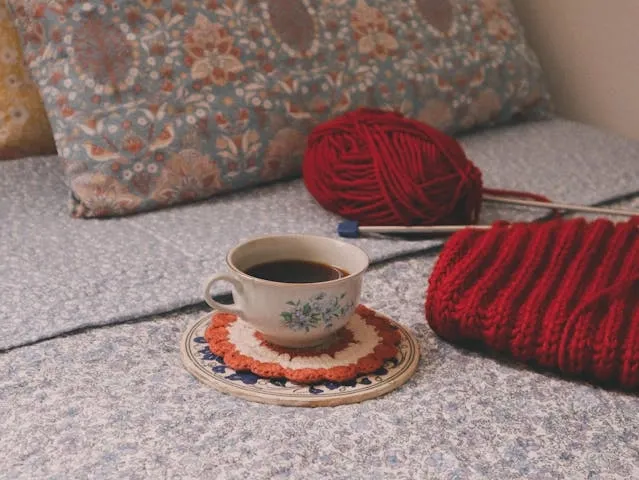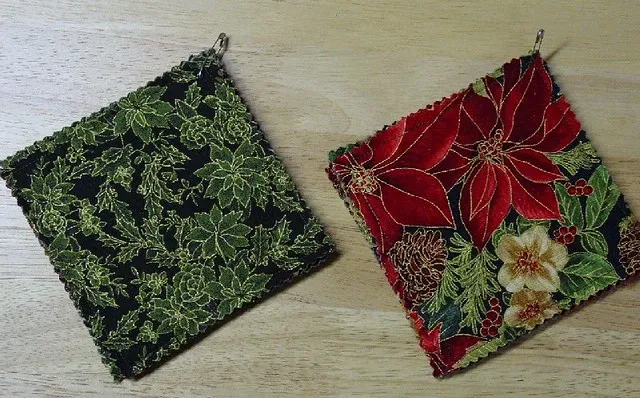Sewing Coasters: Step-By-Step Guide, Fabric Choices, And DIY Techniques
Sewing coasters is an enjoyable DIY project that can bring a touch of charm and practicality to your tabletops. These small fabric pieces protect surfaces from moisture and heat and showcase a unique personal style.
In this guide, we offer tips on how to sew coasters using cotton, linen, or other durable materials. Read on to learn the techniques, materials, and common mistakes to set you up for success, whether you’re an experienced sewer or a beginner looking to learn.

Key Takeaways
- Sewing coasters is a beginner-friendly project to practice basic sewing skills and use leftover fabric.
- You can make sewn coasters by machine or by hand, using durable, absorbent fabrics like cotton, flannel, or linen.
- Coasters sewing is creative and it is a sustainable way to reduce waste, but you should always follow clear measurements and use a rotary cutter for clean cuts.
- We supply high-quality custom coasters in a range of materials and styles so you can bring your vision to life without the DIY sewing work if preferred.
Table of contents
-
Sewing Coasters
-
How To Sew Coasters Step By Step
-
What Is The Best Fabric For Coasters?
-
DIY Fabric Coaster Materials Checklist
-
How To Sew Reversible Fabric Coasters
-
Common Coaster Sewing Mistakes You Should Avoid
-
How To Make A Folded Fabric Coaster
-
Can You Hand Sew Fabric Coasters Instead Of Using A Machine?
-
What Size Should You Cut Fabric For Coasters?
Sewing Coasters
Sewing coasters is all about creating fabric-based coasters using either a sewing machine or hand-stitching techniques. The resulting items serve two purposes: protecting your surfaces and enhancing your home’s aesthetic. For DIYers and sewing enthusiasts, sewn coasters are a go-to project because they are fast and fun and don’t require much fabric.
With these projects, you can experiment on a small scale with:
- Patterns
- Textures
- Sewing techniques
Many beginners choose coaster sewing as an early project because it helps to practice skills like cutting, sewing straight seams, layering, and turning corners. Best of all, it is a great way to use up scrap fabrics, so it is an economical and eco-friendly choice. It is simple to personalize these coasters with techniques like embroidery, decorative stitches, and bold fabric choices.
If you would prefer to avoid the DIY work, you can use our service to create custom personalized coasters using any material.

How To Sew Coasters Step By Step
To sew coasters, start by cutting two fabric squares, typically 5” x 5”, and a matching square of fusible fleece or interfacing. From here, the steps to create sewn coasters are as follows:
- Fuse the fleece to the back of one fabric square using an iron.
- Place the fabric squares right sides together and pin them in place.
- Sew around the edges with a ¼ inch seam allowance, leaving a 2-inch opening.
- Trim the corners for sharper points, then turn the coaster right side out through the opening.
- Press the seams flat and stitch around the edge to close the gap and add a polished look.
Once your coaster is ready, you can place it on tables alongside other accessories like custom cloth napkins and placemats. This simple method teaches skills like turning, pressing, and topstitching, so it is ideal for beginners. With just a few tools and minimal fabric, you’ll master coaster sewing in no time.
DIY Sewing Coasters
DIY sewing coasters becomes an even quicker process when you use pre-cut fabric squares. These are often sold in charm packs. You should choose two squares for each coaster and a single piece of interfacing. For this DIY coaster idea, proceed as follows:
- Iron the interfacing onto one square.
- Then, as in standard sewing, place the right sides together.
- Sew around the edges with a gap for turning, and topstitch.
You can speed the process up by using pre-bonded fleece instead of separate interfacing. In some cases, fabric glue can be used to secure layers temporarily before stitching. For a no-sew edge finish, some DIYers even choose to create coaster sewing shortcuts by folding fabric over and using fusible tape for a sleek edge.
Traditional sewing offers the most durable result, but there are plenty of fast and creative solutions to sew coasters efficiently.
Looking to create an artistic coaster in your own style?
If sewing your own coaster is a little too daunting, why not just create the design and let us do the hard work? We can bring your vision to life for beautiful custom coaster art.
What Is The Best Fabric For Coasters?
The best fabric for sewing coasters is one that balances durability, absorbency, and visual appeal. Cotton is a leading choice for this due to its breathability, ease of sewing, and ability to soak up moisture. Remember, coasters are used for aesthetics as well as practical applications.
Here are some considerations:
- Quilting: With cotton, this technique is widely used for coaster sewing as it holds up well through repeated washing and daily use.
- Linen: Use this for a more textured, natural look, perfect for rustic or minimalist designs.
- Flannel: Though softer, this adds extra absorbency and works excellently as a backing layer.
When you choose fabrics, avoid slippery or synthetic materials as they may not be as absorbent and might even melt under heat. Mix and match patterns to add visual interest, particularly if you are working on reversible sewn coasters.
What Is The Best Yarn To Make Coasters?
If you plan to combine sewing with crochet or edging your coasters, cotton yarn is the top choice. It is heat-resistant, moisture-absorbent, and holds its shape better than synthetic yarns. Coasters are often exposed to hot mugs or cold drinks, so choosing a yarn that won’t warp or melt is essential.
Worsted weight cotton yarn is particularly popular. It is thick enough to bring structure without overwhelming the fabric base. With this type of yarn, you can crochet a decorative border around a sewn coaster, blending fabric and fiber arts. It is also a great choice if you are hand-stitching edges for either aesthetic or functional reasons.
We recommend that you avoid acrylic yarn, as it doesn’t handle heat well and often feels too soft or stretchy for coaster sewing projects. If you want to avoid all these considerations, consider our online store to create custom felt coasters with your own design and take advantage of high-quality craftsmanship and competitive prices.

DIY Fabric Coaster Materials Checklist
To begin your coaster sewing project, gather the essential materials first. Here are the things you will need to make custom personalized coasters with sewing:
- Fabric squares: Cotton and linen are ideal for both the front and back.
- Fusible fleece: This, or medium-weight interfacing, adds structure and absorbency.
- Essential tools: You must prepare sharp fabric scissors or a rotary cutter, a cutting mat, and a ruler or quilting square.
- Thread: This should be a matching or contrasting color, and you will need sewing pins or clips, and an iron to activate fusible materials.
- Sewing machine: This streamlines the process, but it is also possible to hand-sew coasters if you prefer a slower, more meditative approach.
You may also want some tailor’s chalk for marking fabric, a turning tool to achieve crisp edges, and pinking shears to reduce fraying.
Create custom coaster rugs with no sewing or quilting at home
If you want a custom coaster rug without all the hard DIY work, use our service to bring your vision to life. We offer a range of materials and high-quality craftsmanship.
Learn moreHow To Sew Reversible Fabric Coasters
Reversible fabric coasters balance style and practicality as you can get two different looks in one design. They are a good solution for switching up seasonal themes or matching different table settings. You may need to brush up on your sewing techniques to create them, but here are the steps:
- Choose two coordinating or contrasting fabrics, like bold prints paired with solids. Start with two fabric squares and a layer of interfacing or fusible fleece.
- Fuse the stabilizer to one square, then place the right sides of the fabrics together.
- Sew around the perimeter, leaving a small opening.
- Clip the corners, turn the coaster right side out, then press the edges flat.
- Add a final topstitch around the border to close the gap and finish the design.
These sewn coasters are fun to personalize with different fabrics on each side, so experiment with ideas like holiday patterns, color themes, or modern geometric combinations.
Common Coaster Sewing Mistakes You Should Avoid
Avoiding mistakes during coaster sewing is important for saving time and materials. Let’s look at common issues and what causes them:
- Uneven edges: These, or wavy seams, are often caused by poor fabric alignment, improper tension, or not using a quilting ruler for cutting.
- Puckering: Make sure your stabilizer is properly fused and layers are evenly pinned to prevent this.
- Excess bulk: This is usually a consequence of using too thick batting or skipping.
- Fabric shifting: This can happen as you sew coasters, leading to mismatched edges. Address this by using fabric clips.
Accurate seam allowance and consistent stitching are also crucial. If you are not confident you can avoid these mistakes and time is short, a rectangle tablecloth and some creative use of accessories should be enough to get the practical protection and aesthetic appeal you want for your table.
Need a coaster or coaster set with lots of vibrant colors?
When you use our service, you can create custom colorful coasters in a range of styles to bring your vision to life. Whether made from felt or ceramic, enjoy vibrant custom coasters.
How To Make A Folded Fabric Coaster
Folded fabric coasters are often called “cathedral window” or “origami” coasters, and they involve layering and folding fabric. The goal is to create intricate, eye-catching patterns. It also helps meet the global beverage market trend of using more eco-friendly materials.
Here’s how it’s done:
- Start with five fabric squares of the same size - usually 5” x 5”.
- One square serves as the base while the remaining four are folded into triangles and layered around the center.
- Proper layering is key - the open edges of each folded triangle should face inward, forming a square with overlapping flaps.
- Pin the layers in place and sew around the edges, then turn the coaster right-side out and press flat.
With this method of sewing coasters, you create a dimensional, quilted effect without having to add batting. It’s a popular choice for creating gift sets of decorative table settings.
Can You Hand Sew Fabric Coasters Instead Of Using A Machine?
It is definitely possible to hand sew fabric coasters, which is why it is such a portable and calming craft for quiet evenings, travel, or screen-free downtime. Hand stitching is particularly helpful for people who don't have a sewing machine, or for projects that need detailed finishing.
The whip stitch and running stitch are excellent techniques for sewing coasters by hand. Here’s how it’s done:
- Cut and layer your fabric and stabilizer as you would for machine sewing.
- Pin the layers in place.
- Sew around the edges using your chosen stitch.
- Leave a small gap to turn the coaster right side out.
- Finish by pressing and topstitching by hand for maximum durability.
Hand-sewn coasters may take longer to make, but they offer charm and a touch of personalization. Moreover, making them can be very meditative. Good designs include custom floral coasters or geometric patterns.

Embrace the cute aesthetic of hand-sewn coasters without the DIY effort
If you don’t want to sew your own coaster, simply create a chic design and upload it to us. We will bring your custom cute coasters to life with high-quality craftsmanship at competitive prices.
Get startedWhat Size Should You Cut Fabric For Coasters?
The optimal size for sewing coasters is usually based around making a 5-inch square. This aligns with average coaster size and allows enough room for stitching, seam allowance, and padding without becoming too bulky.
For a simple coaster square, cut two fabric pieces and one piece of fusible fleece or interfacing, each 5” x 5”. If you prefer a larger surface, you could go for 5.5” or even 6” squares, particularly if you frequently use oversized mugs or dishes. Always include a seam allowance of ¼ inch on all sides.
For more decorative or shaped sewn coasters, like hexagons or circles, make sure your fabric pieces remain consistent in size to ensure they remain functional and stackable. Precision is key when cutting, so use a rotary cutter, ruler, and mat to maintain clean edges. This will ensure the look and function of your final product are perfect.
Frequently Asked Questions About Sewing Coasters
What Are Sewing Coasters?
Sewing coasters are fabric-based mats stitched together to protect furniture surfaces from heat and moisture. They can be quilted, reversible, padded, or decorative and are commonly made from cotton, linen, or flannel.
What Size Should You Cut Fabric For Coasters?
Fabric squares for sewn coasters are usually cut to 5” x 5”. When you account for seam allowances and padding, this results in a finished surface area of around 4.5”, perfect for most drinkware.